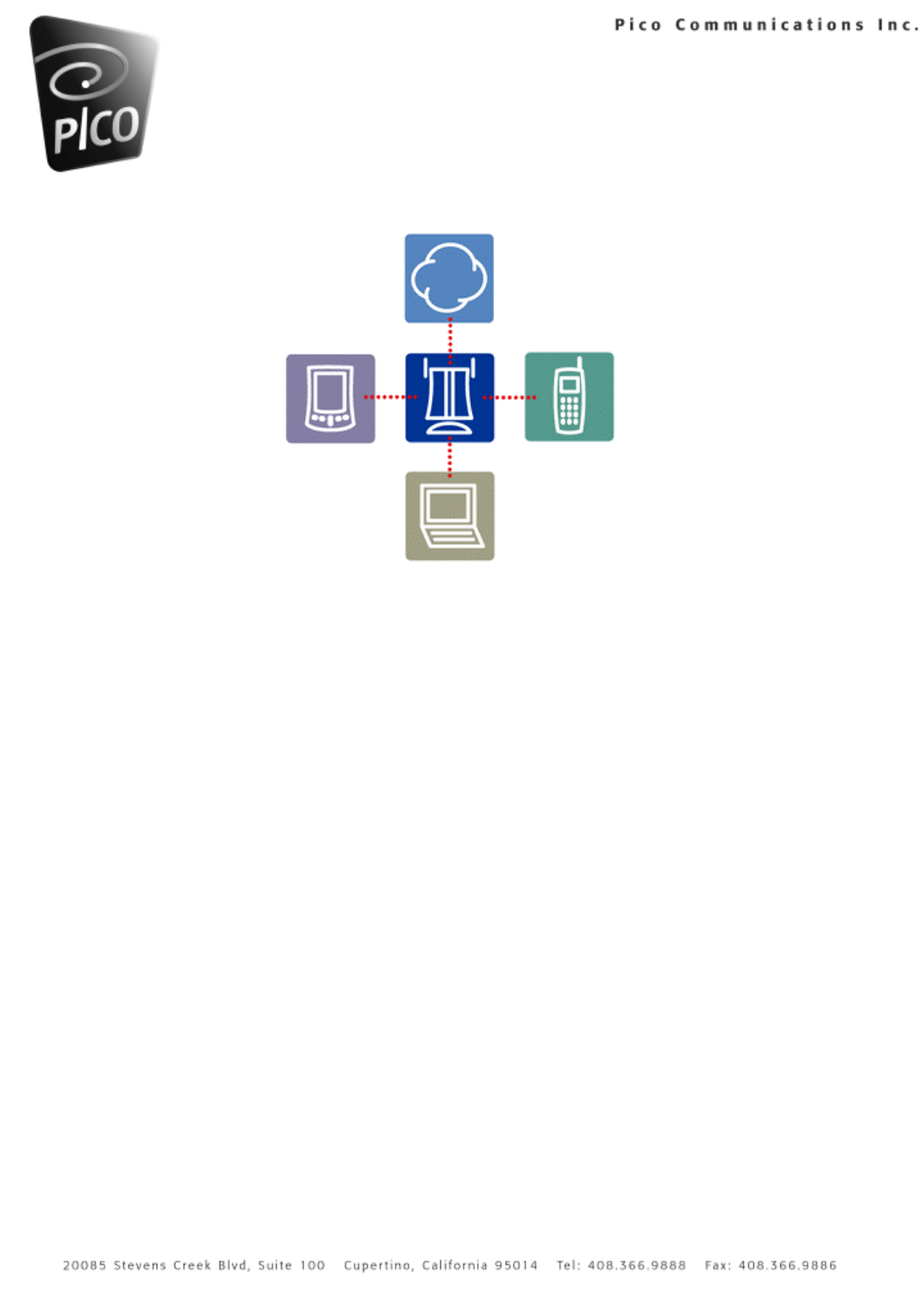Pico Communications PNAP-1A Frequency Hopping Spred Spectrum Transceiver User Manual preliminary
Pico Communications, Inc. Frequency Hopping Spred Spectrum Transceiver preliminary
Users manual

PicoBlue BluetoothTM LAN Access Point setup manual
(For preliminary firmware release)
FCC Statement
This equipment complies with part 15 of the FCC rules.
Operation is subject to the following two conditions: (1) this device may not cause harmful interference, and (2) this
device must accept any interference received, including interference that may cause undesired operation.
Any changes or modifications not expressly approved by the manufacturer could void the user’s authority to operate the
equipment.
To comply with FCC rules regarding RF exposure, this equipment should be installed with a minimum distance of 20cm
away from any personnel.
This device has been tested and found to comply with the limit for a Class B digital device. These limits are designed to
provide reasonable protection against harmful interference in a residential installation.

Overview
The PicoBlue LAN Access Point kit contains the key components to get started with evaluating and
testing the PicoBlue. Included in the kit are the following items:
- 1 PicoBlue (with desk stand)
- 1 power supply
- 1 6ft CAT-5 Ethernet patch cable
- 1 Toshiba Bluetooth PC Card with supplemental installation CD (v1.09 of software)
- 1 hardcopy of this document
This quick start guide will walk you through the steps to get the PicoBlue up, configured, and to
connect to it with the Toshiba Bluetooth PC Card. If you have your own Bluetooth client device,
please follow the instructions that product provides as well. Beyond all this there is no need for
additional software at all. All the software needed to configure the PicoBlue is embedded inside as a
web server and associated pages and forms.
If there are any further questions or support needed, please email: betasupport@pico.net

Minimum Requirements
- 120V/60Hz AC power supply
- RJ45 port to uplink to your local LAN or to the Internet
And if you wish to connect to the PicoBlue with another Bluetooth client, this client will need to
support either the LAN Access Profile or the Dial-Up Networking Profile and have a PPP dialer
installed.
Setup
Summary of steps for setup
- Connecting the cables
- Powering up
- Discovering the PicoBlue Access Point
- Making a Bluetooth connection
- Establishing a PPP connection
- Accessing the web-based configurator
- Accessing the
- Configuring your network parameters
- Accessing the LAN or Internet
Step1: Connecting the cables
First connect up the Ethernet cable (straight) provided to the lower RJ45 port on the side of the unit,
then connect the other end of the cable to your local LAN (wall port, hub, router or cable modem). (
Then connect the power adapter (provided) to your power supply and plug the DC jack into the
PicoBlue.
Step 2: Powering up
After supplying power, the PicoBlue will begin its power up process. This process typically takes 45
seconds after which LED3 and LED6 (LEDs are numbered 1 through 6 from top to bottom) will stay
lit.
Step 3: Discovering the PicoBlue
At this point, you are ready to connect to the PicoBlue Access Point. If you would like to configure the
PicoBlue first, you should connect to it via Bluetooth first, because configuration should be done from
a client device (Note: One can also configure the PicoBlue via an Ethernet connection if it’s IP
address is known. By default though, there is no IP address assigned to the PicoBlue. In the future,
configuration access can be done via the console port with a HyperTerminal client or via SNMP).

If you are using the Toshiba PC card as the Bluetooth client, please follow their instructions for
installing the PC card onto your notebook PC as well as for launching their Bluetooth Neighborhood
application to initiate the discovery process. Please be sure to install only the V1.09 of their
software that we have provided. Do not use any other version of their software.
If you are using another Bluetooth client device to access the PicoBlue, please follow the standard
instructions from that device to initiate a discovery.
Step 4: Making the Bluetooth connection
If you are using the Toshiba PC card provided, follow their instructions for making the LAN Access
Profile connection or a Dial-Up networking connection.
If you are using another Bluetooth device, please follow their respective instructions for establishing
either the LAN Access profile or Dial-up Networking profile connection.
Step 5: Establishing a PPP connection
If you are using the Toshiba PC card, you then need to install the RAS serial modem profile
(filename: ***) we have provided on the Toshiba installation CD. Configure your dial up networking
to dial with this serial modem. Launch a PPP session with this dial-up setup. There is no need to
specify a username or password at this time. Click on connect. After completing the logon process,
your PPP session will be up.
If you are using another Bluetooth device, please follow their respective instructions on establishing a
PPP connection.
At this point, if you have plugged the PicoBlue onto a network with a DHCP server, you should be
able to start accessing the Internet. However, if your network has no DHCP server, you will need to
proceed to Step 6 and assign the PicoBlue AP a fixed IP address.
Note that LED3 will now blink steadily when there is data activity.
Step 6: Accessing the web-based configurator via Bluetooth or via Ethernet
From the Bluetooth client device that you have just connected to the PicoBlue, launch a web browser
and direct it to the following URL: HTTP://192.168.10.3:8080 (note that the IP address is 1 lower
than the one assigned to your client device. If you are the first unit, your assigned IP will be
192.168.10.4 and the AP’s IP from behind the NAT will be 192.168.10.3)
If you know the IP address of the AP and you are on the same network, you can access the same
configuration pages by using its IP address instead. Remember to use port 8080 when doing this.
(HTTP’ing to the IP address of the AP, without specifying port 8080, will bring you to the RAMdisk
HTTP server)

You will first be asked for an Administrative username and password. By default there is one
Administrative user “Pico” and the password is “Pico” (you will be able to change this once you get
into the configuration pages). Type this in and click OK.